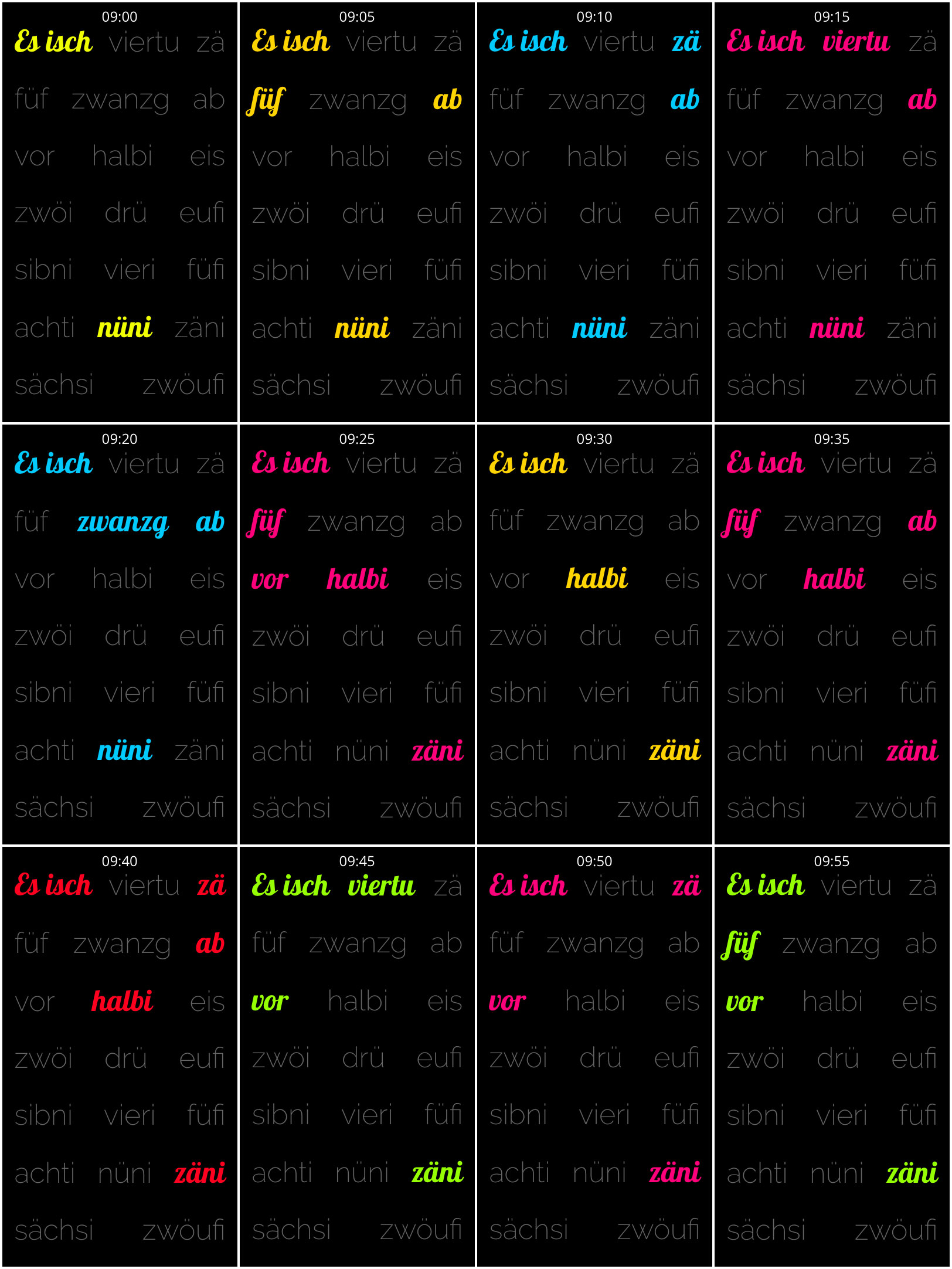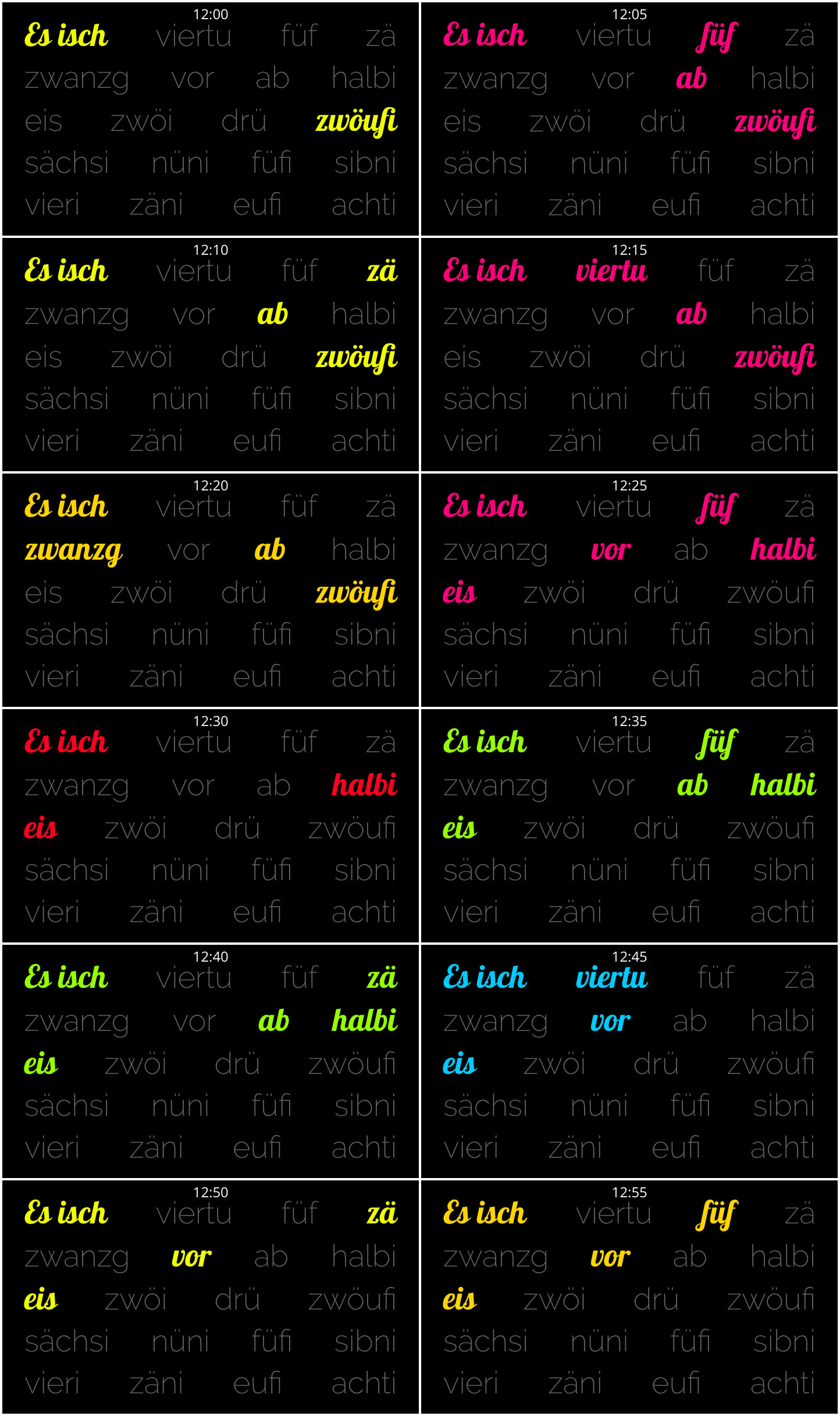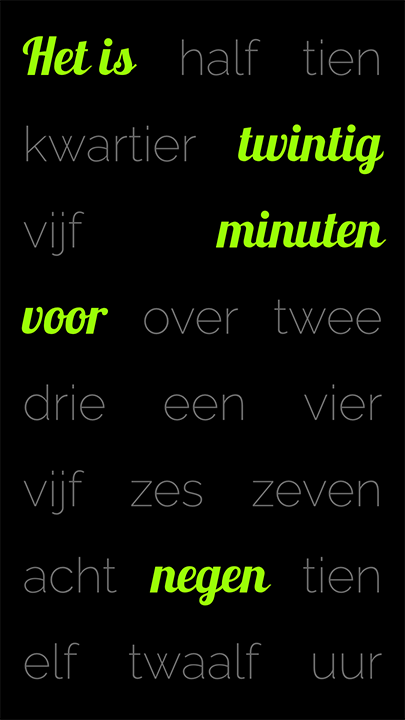Read the statement by Michael Teeuw here.
Help Translating Word Clock
-
@j-e-f-f I found this german word clock. Could be a help for the layout of the words.
-
word clock for CJK
If you cannot see characters of this document in your browser properly, tell me please. (In that case, you should install CJK fonts like
Google Noto)General
- Chinese, Japanese, Korean fonts are composited by multi-byte characters
- They use 12H system, but in military, science and public service, 24H system is also used.
- In 24H system, they use
00 hour, but usually in 12H system, they call it12 hour.
e.g)12:10is calledpm 12:10,00:10is calledam 12:10. - Traditionally they use
dawn-morning-daylight-evening-nighttime slot system, but the borders between slots are very ambiguous, thereforeamandpmsystem is more normally used nowadays. - Unlike the known, Chinese, Japanese and Korean are not kin-languages. They have no embryological and lingual relation each other. But they shared so many words because they had used same characters historically.
- Chinese and Japanese don’t use whitespace between words, but Korean do. However, You don’t need to consider that point in wordclock.
- They read numbers as 10-based decimal digits not 12-based duodenary like Western. And they read numbers from left to right always without exception.
- in CJK, reading multi-digits numbers are based on 10-digits multiplication.
So, from 1 to 9 is just read as 1 - 9, and 10 is 1 * 10, 100 is 1 * 100 and you can calcluate how it goes. (e.g.123is1*100+2*1*10+3)
number Chinese Japanese Korean 1 一一일10 (1 * 10) 十十십11 (1 * 10) + 1 十一十一십일12 (1 * 10) + 2 十二十二십이20 2 * (1 * 10) 二十二十이십21 2 * (1 * 10) + 1 二十一二十一이십일Japanese
The only serious problem is that Japanese KANJI(borrowed characters from Chinese) string could be read differently in each context. However, We don’t need to consider how the text is read and pronounced. ^^; It’s none of our business.
They don’t use white spaces between words, but in this document, I add space for your understanding.Japanese clock scheme
Simplest Version
{ 'timeslot' : {'午前', '午後'}, // 'am', 'pm' '10hour' : {'十'}, // '1*10' 'under10hour' : {'一', '二', '三', '四', '五', '六', '七', '八', '九'}, // '1', '2', '3', '4', '5', '6', '7', '8', '9' 'hoursymbol' : {'時'}, // 'hour' 'over10min' : {'二', '三', '四', '五'}, // '2', '3', '4', '5' '10min' : {'十'}, // '1*10' 'each5min' : {'五'}, // '5' 'minutesymbol' : {'分'}, // 'minute' }example)
am 01:00 =>午前 一 時
am 02:05 =>午前 二 時 五 分
am 03:10 =>午前 三 時 十 分
am 04:15 =>午前 四 時 十 五 分
am 05:20 =>午前 五 時 二 十 分
am 06:25 =>午前 六 時 二 十 五 分
pm 07:30 =>午後 七 時 三 十 分
pm 08:35 =>午後 八 時 三 十 五 分
pm 09:40 =>午後 九 時 四 十 分
pm 10:45 =>午後 十 時 四 十 五 分
pm 11:50 =>午後 十 一 時 五 十 分
pm 12:55 =>午後 十 二 時 五 十 五 分
That’s all.Is it too easy? Here is more formal version.
Formal Version{ 'phrasestart' : {'今は'}, // 'Now, it is...' 'timeslot' : {'午前', '午後'}, // 'am', 'pm' '10hour' : {'十'}, // '1*10' 'under10hour' : {'一', '二', '三', '四', '五', '六', '七', '八', '九'}, // '1', '2', '3', '4', '5', '6', '7', '8', '9' 'hoursymbol' : {'時'}, // 'hour' 'justat' : {'定刻'}, // 'just, sharp at hour' 'halfhour' : {'半'}, // 30min 'over10min' : {'二', '三', '四', '五'}, // '2', '3', '4', '5' '10min' : {'十'}, // '1*10' 'each5min' : {'五'}, // '5' 'minutesymbol' : {'分'}, // 'minute' 'before' : {'前'}, // to use XX min before hour 'phraseend' : {'です。'}, // ending symbol of phrase }- You can add
'今は'and'です。'for making full sentence.
It is am 02:05. =>今は 午前 二 時 五 分 です。 - You can use
'定刻'afterhoursymbolfor displaying ‘just at hour’.
It is exactly am 01:00. =>今は 午前 一 時 定刻 です。 - You can use
'半'for displaying half-hour.
It is pm 07:30. =>今は 午後 七 時 三 十 分 です。=>今は 午後 七 時 半 です。 - You can use
'前'for small minutes before hour. (usually below 15 minutes)
5 mins before =>'五分前'
10 mins before =>'十分前'
15 mins before =>'十五分前'
It is pm 10:45. =>今は 午後 十 時 四 十 五 分 です。=>今は 午後 十 一 時 十 五 分 前 です。
Korean
It is same with the formal Japanese version, but with Korean own characters.
{ 'phrasestart' : {'지금은'}, // 'Now, it is...' 'timeslot' : {'오전', '오후'}, // 'am', 'pm' '10hour' : {'열'}, // '1*10' 'under10hour' : {'한', '두', '세', '네', '다섯', '여섯', '일곱', '여덟', '아홉'}, // '1', '2', '3', '4', '5', '6', '7', '8', '9' 'hoursymbol' : {'시'}, // 'hour' 'justat' : {'정각'}, // 'just, sharp at hour' 'halfhour' : {'반'}, // 30min 'over10min' : {'이', '삼', '사', '오'}, // '2', '3', '4', '5' '10min' : {'십'}, // '1*10' 'each5min' : {'오'}, // '5' 'minutesymbol' : {'분'}, // 'minute' 'before' : {'전'}, // to use XX min before hour 'phraseend' : {'입니다.'}, // ending symbol of phrase }It is exactly am 01:00 =>
지금은 오전 한 시 정각 입니다.
It is am 02:05 =>지금은 오전 두 시 오 분 입니다.
It is am 03:10 =>지금은 오전 세 시 십 분 입니다.
It is am 04:15 =>지금은 오전 네 시 십 오 분 입니다.
It is am 05:20 =>지금은 오전 다섯 시 이 십 분 입니다.
It is am 06:25 =>지금은 오전 여섯 시 이 십 오 분 입니다.
It is pm 07:30 =>지금은 오후 일곱 시 삼 십 분 입니다.=>지금은 오후 일곱 시 반 입니다.
It is pm 08:35 =>지금은 오후 여덟 시 삼 십 오 분 입니다.
It is pm 09:40 =>지금은 오후 아홉 시 사 십 분 입니다.
It is pm 10:45 =>지금은 오후 열 시 사 십 오 분 입니다.=>지금은 오후 열 한 시 십 오 분 전 입니다.(It is 15 min before pm 11:00)
It is pm 11:50 =>지금은 오후 열 한 시 오 십 분 입니다.=>지금은 오전 열 두 시 십 분 전 입니다.(It is 10 min before am 12:00)
It is pm 12:55 =>지금은 오후 열 두 시 오 십 오 분 입니다.=>지금은 오후 한 시 오 분 전 입니다.(It is 5 min before pm 01:00)Chinese (Simplified) - Usually used in Chinese culture except for Taiwan
It is slightly different with Japanese formal version.
They don’t use white spaces between words, but in this document, I add space for your understanding.{ 'phrasestart' : {'现在'}, // 'Now, it is...' 'timeslot' : {'上午', '下午'}, // 'am', 'pm' 'hour' : {'一', '两', '三', '四', '五', '六', '七', '八', '九', '十', '十一', '十二'}, // '1', '2', '3', '4', '5', '6', '7', '8', '9', '10', '11', '12' 'hoursymbol' : {'点'}, // 'hour' 'justat' : {'钟'}, // 'just, sharp at hour' 'halfhour' : {'半'}, // 30min 'quarterhour' : {'一刻', '三刻'}, // 15min, 45min 'over10min' : {'二', '三', '四', '五'}, // '2', '3', '4', '5' '10min' : {'十'}, // '1*10' 'each5min' : {'五'}, // '5' 'minutesymbol' : {'分'}, // 'minute' 'phraseend' : {'。'}, // ending symbol of phrase }- In Chinese, they have also ‘XX min before’ expressions, but it needs changing structure of words positions. So It’s better to ignore those.
It is exactly am 01:00. =>
现在 上午 一 点 钟 。
It is am 02:05. =>现在 上午 两 点 五 分 。
It is am 03:10. =>现在 上午 三 点 十 分 。
It is am 04:15. =>现在 上午 四 点 十 五 分 。=>现在 上午 四 点 一刻 。
It is am 05:20. =>现在 上午 五 点 二 十 分 。
It is am 06:25. =>现在 上午 六 点 二 十 五 分 。
It is pm 07:30. =>现在 下午 七 点 三 十 分 。=>现在 下午 七 点 半 。
It is pm 08:35. =>现在 下午 八 点 三 十 五 分 。
It is pm 09:40. =>现在 下午 九 点 四 十 分 。
It is pm 10:45. =>现在 下午 十 点 四 十 五 分 。=>现在 下午 十 点 三刻 。
It is pm 11:50. =>现在 下午 十一 点 五 十 分 。
It is pm 12:55. =>现在 下午 十二 点 五 十 五 分 。 -
@Sean This is great! I’ll tackle this in the first week of September as I’m traveling next week, and this week is fairly busy as a result. But it looks to be a great challenge!
-
@Atteraxol @Sean @strawberry-3-141 @pjkoeleman @willfri There seems to be some disagreement as to which is correct when telling time in German:
For twenty past the hour (e.g.: 3:20), which of the following is more common (i.e.: if I were to make just one translation, which would be more familiar for most people?)
Es ist zwanzig nach drei
- or -
Es ist zehn vor halb vierAnd similarly for twenty minutes to the hour:
Es ist zwanzig vor vier
- or -
Es ist zehn nach halb vierOr does it matter? Are both equally correct?
-
@j.e.f.f both versions are correct. I’m using the first one, not sure if this is more common or a regional thing.
-
@j-e-f-f I never heard of the second version so it’s probably not so common. (native German speaker)
-
OK I just pushed a fairly significant update. If you are currently using this module, and you would like to use the update, the configuration has changed. Instead of the
layoutparameter, you now specify the desired language, and your screen orientation. Example:{ module: "MMM-MyWordClock", position: "fullscreen_above", disabled: false, config: { showClockTimeOut: 1000, langauge: "EN", orientation: "tall" //or "wide" } }The following languages are now supported:
ENEnglish (default)DEGermanDE_CHSwiss GermanFRFrenchNLDutch
The best part of this update is that you can also specify
*for the language. This will trigger the clock to pick one of the supported languages at random each time it updates!I’m traveling all next week, but in the following week I’ll be adding the following languages:
DADanishZHChinese SimplifiedJAJapaneseKOKoreanTLTagalog (Philipino)
Thanks to everyone for your help!
-
@strawberry-3.141 I worked your Swiss German layout into the code. I couldn’t do a straight merge as I was also in the middle of re-architecting the code base. But I copied your layout files and modified them to work with the new system. I also rearranged some of the layout to have the words spaced out better. I don’t think I messed up the translation as a result – having spent so much time on the German one helped me understand yours – but when I get a few free seconds, I’ll post screenshots so you can validate.
-
@strawberry-3-141 As promised, here are screenshots of the layout integrated, both for the tall and wide layouts. Please let me know if it looks good
Tall:

Wide:

-
09:40 would be correct:
Es isch zwanzg vor zäni12:40 the same:
Es isch zwanzg vor eisThe rest looks fine :-)
By the way (you dont have to change it) but usualy we say “zwänzg” not “zwanzg” ;-)


